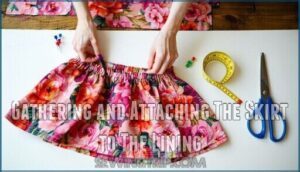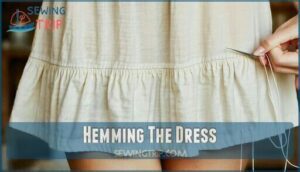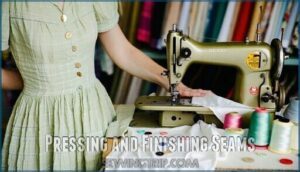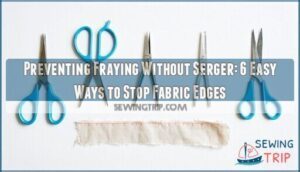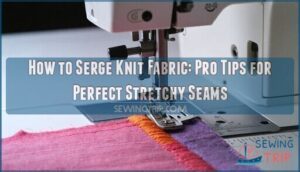This site is supported by our readers. We may earn a commission, at no cost to you, if you purchase through links.
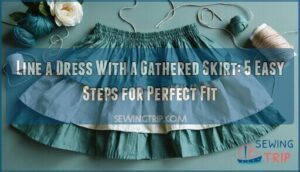 You’ll line a dress with a gathered skirt by creating a smooth interior layer that eliminates transparency and reduces static cling.
You’ll line a dress with a gathered skirt by creating a smooth interior layer that eliminates transparency and reduces static cling.
Start by cutting lining pieces that match your bodice but create a simple A-line skirt instead of gathering the lining fabric.
Attach the lining to your bodice first, then sew the gathered outer skirt to both the lining and bodice at the waistline.
This technique keeps the lining flat while preserving the skirt’s beautiful fullness. The key is understanding that your lining doesn’t need to match every gather – it just needs to provide structure underneath.
There’s actually a clever trick that makes the waist attachment foolproof.
Table Of Contents
- Key Takeaways
- How to Line a Dress With a Gathered Skirt
- Why is Lining Important for a Gathered Skirt Dress?
- What Materials Do You Need to Line a Dress With a Gathered Skirt?
- Step-by-Step Guide: Lining a Dress With a Gathered Skirt
- Tips and Tricks for Lining a Dress With a Gathered Skirt
- Common Mistakes to Avoid When Lining a Dress With a Gathered Skirt
- Adding a Lining to Your Gathered Skirt Dress: Alternatives and Variations
- Frequently Asked Questions (FAQs)
- Conclusion
Key Takeaways
- Cut your lining fabric shorter than the outer skirt – You’ll want the lining to be about 1 inch shorter than your gathered skirt to prevent it from peeking out below the hemline while maintaining proper drape.
- Create a simple A-line lining instead of gathering it – You don’t need to gather your lining fabric; cut it as a basic A-line shape that provides structure underneath while letting the outer skirt maintain its beautiful fullness.
- Attach the lining to the bodice first, then add the gathered skirt – You’ll get the best results by securing your lining to the bodice before attaching the gathered outer skirt to both layers at the waistline.
- Use lightweight, smooth lining fabrics for comfort – Choose materials like cotton batiste, silk, or polyester lining that won’t add bulk or cling to your skin while providing the opacity and structure you need.
How to Line a Dress With a Gathered Skirt
You’ll learn how to line a dress with a gathered skirt in five straightforward steps that create a professional, comfortable finish.
This technique transforms your homemade dress into a polished garment that feels as good as it looks, providing a polished finish.
Understanding The Construction of a Gathered Skirt
Before you begin lining your gathered skirt dress, you’ll need to understand how these charming pieces work.
A gathered skirt is basically a wide rectangle of fabric that’s bunched up at the waist to create that perfect vintage silhouette.
Transform flat fabric into flowing elegance with simple gathering techniques that create timeless vintage charm.
Here’s what makes gathered skirt construction unique:
- Fabric Width determines fullness – typically 1.5 to 3 times your waist measurement
- Gathering Techniques use two parallel rows of loose stitches to create even pleats
- Waistband Options include elastic, fitted bands, or direct attachment to bodice
- Silhouette Variations range from subtle A-line to full circle depending on fabric amount
The gathering stitch is your best friend here – it transforms flat fabric into dimensional beauty.
Understanding skirt construction helps you plan your dress lining approach, ensuring both layers work together seamlessly for proper Hem Finishes.
Preparing The Lining Fabric
Now that you understand how gathered skirts work, let’s prep your lining fabric properly. Choose lightweight materials like silk or cotton for comfort. Pre-washing lining prevents shrinkage disasters later. Cut lining pieces following the fabric’s grain direction for better drape. Lining sheer fabrics can also enhance opacity and comfort.
| Fabric Type | Weight | Best For |
|---|---|---|
| Cotton voile | Lightweight | Casual dresses |
| Silk habotai | Ultra-light | Formal wear |
| Polyester crepe | Medium-light | Everyday use |
| Cotton lawn | Light | Summer dresses |
| Rayon bemberg | Smooth-light | Vintage styles |
Your cutting techniques matter – use sharp scissors and mark notches clearly. This prep work sets you up for smooth sewing ahead.
Attaching The Lining to The Bodice
Now that you’ve prepared your lining fabric, it’s time to attach it to the bodice using proper bodice lining techniques.
Pin the lining to the bodice’s neckline and armholes, matching notches for gathering point alignment.
Sew with right sides together, then understitch to prevent rolling.
This dress lining tutorial step creates the foundation for waistband attachment later, ensuring your sew dress lining project stays secure throughout the dress lining instructions process.
Adding The Gathered Skirt to The Lining
Now you’ll join your skirt to the lining, creating the dress’s foundation.
Pin the gathered skirt to the lining’s waistband, matching side seams and center points.
Use proper gathering techniques to distribute fullness evenly, and sew carefully, adjusting darts placement as needed.
This step transforms separate pieces into a cohesive gathered skirt dress with perfect lining fullness, resulting in a dress with a well-structured foundation.
Finishing Touches and Final Steps
After attaching your gathered skirt to the lining, you’ll need to perfect the final details.
Start by applying proper seam finishes to prevent fraying – serging or zigzag stitching works well.
Choose appropriate closure options like invisible zippers or buttons for your gathered skirt dress.
Complete hemming techniques by measuring twice and cutting once.
Add waistband detailing for a professional look, and ensure final pressing guarantees your dressmaking techniques shine, making lining a dress worthwhile.
Why is Lining Important for a Gathered Skirt Dress?
A well-lined gathered skirt dress transforms your sewing project from amateur to professional.
Lining provides comfort enhancement by creating a smooth barrier between your skin and potentially scratchy outer fabric.
You’ll notice improved silhouette improvement as the lining prevents fabric from clinging awkwardly to your body.
Opacity solutions become critical with lighter fabrics – nobody wants surprises when sunlight hits their dress.
The gathering process creates beautiful volume, but without proper lining, gathered skirts can bunch uncomfortably.
Lining fabric types like silk or cotton add durability boost while maintaining excellent drape quality, ensuring your creation looks polished and moves gracefully.
What Materials Do You Need to Line a Dress With a Gathered Skirt?
Getting your materials straight sets you up for success when lining a dress with a gathered skirt. You’ll need the right combination of fabrics and tools to create a polished finish that feels as good as it looks.
Start by choosing lightweight, smooth lining fabric that won’t add bulk or cling to your skin. Cotton batiste, silk, or polyester lining work beautifully for gathered skirts. Calculate your fabric needs by measuring 1.5 times your hip measurement for basic fullness.
Essential materials include:
- Lining fabric types: Cotton batiste, silk, or lightweight polyester in coordinating colors
- Thread color matching: Choose thread that blends with both your main fabric and lining
- Fastener considerations: Zippers, buttons, or hook-and-eye closures for proper fit
- Interfacing needs: Lightweight interfacing for waistband stability and structure.
Don’t forget your hem allowance tools like measuring tape, fabric scissors, and pins. These basics guarantee your gathered skirt hangs beautifully while the lining provides comfort and prevents transparency issues.
For summer skirts, consider breathable linen options to enhance comfort.
Step-by-Step Guide: Lining a Dress With a Gathered Skirt
You’ll create a professional-looking lined dress by following these four clear steps that build on each other.
Each step focuses on a specific part of the process, from cutting your lining pieces to finishing the hem with precision.
Each step focuses on a specific part of the process.
Cutting and Sewing The Lining Pieces
With your lining fabric choice made, start by cutting pieces using your dress pattern.
Line up the grainline alignment perfectly—this prevents unwanted twisting later.
Cut lining fabric 10cm shorter than your skirt length.
When sewing lining pieces together, focus on dart placement for a streamlined fit.
Use sharp shears for clean edges, especially with slippery fabrics.
Consider using specialized fabric shears for this task.
This foundation sets you up for successful skirt lining attachment, using your dress pattern to achieve a professional finish.
Gathering and Attaching The Skirt to The Lining
Now you’re ready to create the signature fullness that makes gathered skirts so charming. The gathering stitch transforms your flat fabric into beautiful, even gathers that flow naturally from waist to hem.
Here’s your roadmap for perfect gathering:
- Sew two parallel gathering stitches along the skirt’s waist edge, spacing them 1/4 inch apart
- Pull bobbin threads gently to create even gathering across the entire waistband attachment area
- Distribute gathers evenly between side seams, pinning frequently to maintain consistent fullness
- Stitch the waist seam with gathers facing up, using proper seam finishes to prevent fraying
Match your skirt lining width to the gathered skirt’s measurements. This guarantees your lining darts won’t pucker and your hemming techniques will create a smooth, professional finish.
Adding a Zipper or Closure
Your skirt’s foundation is solid, so now you’ll add the closure that brings everything together. Choose from several zipper types and alternative closures to match your dress construction methods and personal style preferences.
When lining a dress with a gathered skirt, the closure becomes your final puzzle piece. Position an invisible zipper at the center back seam for the cleanest finish, or explore these popular options:
- Invisible Zippers – Blend seamlessly into the seam, perfect for formal dresses and maintaining clean lines
- Button Loops – Create vintage charm with fabric loops paired with covered buttons along the back opening
- Hook-Eye Closures – Offer secure, flat fastening ideal for fitted bodices and formal wear applications
- Alternative Closures – Consider snap tape, magnetic closures, or decorative ties for unique design elements
Install your chosen closure after securing the waistband seam. To guarantee stability, consider using interfacing for thin fabrics. This sequence prevents puckering and guarantees your dress sewing tips pay off with professional results.
Hemming The Dress
With your zipper securely in place, you’re ready to hem the dress.
Begin by trying on the dress to determine the perfect hem length. Mark the desired length with pins, then fold the raw edge up twice to create a clean finish.
For lining a dress with a gathered skirt, use a blind hemming stitch to keep the hem invisible from the outside. Press the fold gently to maintain the gathered skirt’s shape and volume, ensuring a clean finish.
Tips and Tricks for Lining a Dress With a Gathered Skirt
Mastering these essential tips will transform your gathered skirt dress from amateur to professional-looking garment in no time.
You’ll save hours of frustration and achieve that perfect drape that makes store-bought dresses look expensive.
Using Stay Tape for Stability
Stay tape works like a safety net for your gathered skirt dress, preventing those pesky fabric stretches that can ruin your hard work. This narrow strip of interfacing becomes your secret weapon for professional-looking results.
Here’s how to apply stay tape for maximum stability:
- Place stay tape along curved seam areas where fabric naturally wants to stretch during wear
- Stitch directly through the tape when sewing seams to lock everything in place
- Focus on waistlines and armholes where gathered fabric creates the most stress points
Different stay tape types work better for specific areas – twill tape handles curves beautifully, while straight-grain tape excels at waistlines.
Choosing The Right Lining Fabric
Your lining fabric choice makes or breaks your gathered skirt dress project.
Fabric weight should match your outer material – lightweight silky polyester works perfectly with summer dresses, while heavier options suit winter garments.
Breathability matters for comfort, especially with natural fibers like cotton.
Color considerations include matching or complementing your main fabric to prevent show-through.
Care requirements must align between lining and outer fabric for easy maintenance.
A smooth texture enhances garment comfort and ease for garment comfort and is crucial for the overall outer material and lining fabric choice.
Pressing and Finishing Seams
Perfect seam pressing transforms your gathered skirt dress into a professional-looking garment that’ll make you feel like a sewing rockstar.
Here’s how to achieve those crisp, clean finishes:
- Seam Pressing – Press seams toward the bodice using a pressing cloth to protect delicate lining fabrics
- Understitching Tips – Stitch lining to seam allowances to prevent rolling and maintain clean edges
- Clean Finishes – Use pinking shears or zigzag stitches to prevent fraying on raw edges
- Bias Binding – Apply bias tape to curved seams for a couture-level finish that lasts
- Serged Edges – Finish seams with a serger for durability and professional appearance in your lined dress.
Using the right pressing cloth options guarantees the best results.
Adjusting The Fit of The Lining and Skirt
After achieving perfectly pressed seams, you’ll want to fine-tune your dress fit for that professional look.
Try on your lined dress and check for any pulling or bunching around the waist.
If the lining darts feel too tight, you can let them out slightly. Adjusting gathers at the waistband helps control waistband tension and improves silhouette shaping.
Your skirt lining guide should emphasize that hem length matching between lining fabric and outer fabric creates the best dress fit when lining a dress with a gathered skirt.
Common Mistakes to Avoid When Lining a Dress With a Gathered Skirt
Even experienced sewers can make simple mistakes that compromise the final result when lining a gathered skirt dress.
These common errors often lead to uneven hems, puckered seams, or a dress that doesn’t hang properly.
Not Matching The Lining to The Skirt Length
One common blunder you’ll encounter when lining a dress with a gathered skirt involves mismatched lining length.
Many sewers cut their lining fabric the same length as the outer skirt, creating bunching and awkward layering effects.
Your lining should be approximately one inch shorter than your gathered skirt to prevent peeking below the hemline.
This intentional shortening guarantees visual interest without practicality concerns, giving your skirt lining guide professional results.
Remember to keep in mind fabric shrinkage concerns when pre-washing your materials.
Overlooking The Importance of Understitching
Skipping understitching is like building a house without a foundation—it looks fine until everything starts falling apart.
This vital technique prevents your lining from rolling out and creates a professional finish by securing seams against the lining fabric.
When you understitch, you’re basically taming rebellious fabric edges that want to peek out and ruin your dress’s sleek appearance.
Rushing The Gathering Process
When you’re racing against the clock with lining a dress, hasty gathering creates more problems than solutions.
Poor gathering stitch technique leads to uneven gathers that bunch awkwardly, while rushed sewing techniques cause fabric distortion and seam puckering, resulting in poor fit that requires time-consuming repairs.
- Uneven Gathers – Hurried pulling creates irregular pleats that make your lining fabric bunch unevenly across the waistline
- Fabric Distortion – Yanking gathering threads too quickly stretches the material, causing permanent warping in delicate lining fabric
- Seam Puckering – Racing through the attachment process creates tension issues that result in visible wrinkles along the waist seam
- Poor Fit – Rushed time management during gathering leads to improper distribution, making the final dress uncomfortable and unflattering
Neglecting to Secure The Waist Seam
You’re setting yourself up for disaster when you skip reinforcing the waist seam properly.
This vital junction bears all the seam stress from your gathered skirt’s weight and movement, making bodice stability essential.
Without proper waistband support through reinforcement methods like stay tape or French seams, your beautiful work will literally fall apart at the waist.
Adding a Lining to Your Gathered Skirt Dress: Alternatives and Variations
You don’t have to use traditional full lining methods when adding comfort and structure to your gathered skirt dress.
These alternative approaches let you customize the level of coverage, add visual flair, or create extra volume while maintaining the dress’s beautiful silhouette.
The ability to add visual flair is a key aspect of these methods, allowing for a range of creative possibilities.
Partial Lining for Comfort and Movement
Partial lining offers three key benefits for your gathered skirt dress: reduced bulkiness, enhanced comfort, and improved movement.
This DIY dress lining technique involves cutting lining fabric shorter than the main skirt, typically 1-1.5 inches above the hem. Strategic Lining Placement prevents the lining from peeking out while maintaining how to line dress functionality.
For the lining, satin or similar fabrics are often chosen to provide needed opacity.
- Upper portion attachment – Secure lining to bodice only, leaving lower skirt unlined for Movement Enhancement
- Shortened length approach – Cut lining fabric with Comfort Focus, ending above main hem line
- Breathable construction – Choose lightweight lining fabric to avoid adding unnecessary bulk to gathered skirt pattern
- Modesty coverage – Provide opacity where needed while embracing Partial Styles for improved airflow
Using a Contrast Lining for Visual Interest
While partial lining offers comfort, contrast lining transforms your gathered skirt dress into a stunning statement piece.
This sewing technique creates unexpected visual drama through strategic Color Combinations and Bold Statements that peek through your outer fabric.
Choose contrast lining fabric that complements your main dress while adding personality.
Consider these approaches:
- Peekaboo Effects: Let vibrant lining show through movement or strategic cutouts
- Trim Accents: Use contrasting fabric for hem details or decorative edging
- Unexpected Details: Add patterned lining beneath solid outer fabric for surprise elements
Your lining fabric should remain lightweight and smooth, ensuring proper drape while creating these visual surprises.
Incorporating a Slip or Petticoat for Extra Volume
Your dress’s transformation begins with choosing the right undergarments.
Slips provide smooth lines and prevent clinging, while petticoats create dramatic volume through structured layers.
Multiple petticoats deliver maximum fullness for vintage-inspired silhouettes.
| Petticoat Styles | Volume Options | Fabric Choices |
|---|---|---|
| Tulle layers | Subtle lift | Lightweight, airy |
| Crinoline structure | Maximum drama | Stiff, supportive |
| Organza tiers | Elegant volume | Sheer, delicate |
| Cotton comfort | Moderate fullness | Soft, breathable |
| Netting support | Heavy dress support | Structured, durable |
Consider slip length—it should fall shorter than your gathered skirt to avoid peeking out.
For comfort considerations, choose cotton-lined petticoats against sensitive skin.
The right lining fabric enhances volume enhancement while maintaining comfort throughout wear.
Frequently Asked Questions (FAQs)
How do you line a gathered skirt in dressmaking?
You’ll cut your lining fabric the same width as your skirt but 10cm shorter.
Layer it over the skirt fabric, align the sides, and sew with a zig-zag stitch before gathering both layers together at the waistband.
How do you make a dress with a gathered skirt?
Nearly 75% of sewers find gathered skirts easier than circle skirts for beginners.
You’ll cut fabric 5-3 times your waist measurement, create two gathering rows, then attach to your bodice.
The cylindrical shape creates that perfect vintage puff at the waist.
How do you line a dress with a gathered skirt?
You’ll create a smoother, more polished garment by carefully measuring your lining fabric to match the skirt’s width but cutting it shorter.
Attach the lightweight lining to your gathered waistband for comfort.
How do you attach a lining to a gathered skirt?
Layer your lining fabric over the gathered skirt, aligning raw edges except at the hem.
Sew together with a zig-zag stitch, then attach the combined layers to your waistband using gathering techniques.
Do I need a pattern for a simple gathered skirt?
No, you don’t need a pattern for a simple gathered skirt. Just calculate fabric width (5-3 times your waist measurement) and add your desired length plus hem allowance. It’s beginner-friendly!
What is a gathered skirt?
A gathered skirt is absolutely the easiest skirt style you’ll ever make! It’s cylindrical fabric with extra width at the waist that’s bunched into soft folds for a vintage-inspired silhouette.
What fabric is best to line inside of skirts?
Choose lightweight, smooth fabrics like silk, polyester, or cotton for lining.
These materials prevent clinging, add comfort, and won’t create bulk.
You’ll want breathable options that match your outer fabric’s color for the best results, using materials like cotton.
Can you line a vintage gathered skirt dress?
You can absolutely line a vintage gathered skirt dress – it’s not rocket science.
Simply cut lightweight lining fabric (like silk or cotton) the same width as your skirt but 10cm shorter.
Attach it at the waist for comfort and structure.
How do you handle stretchy gathered skirt fabric?
Use a walking foot and stretch needle when sewing stretchy gathered skirt fabric. Pin frequently, don’t pull the fabric while stitching, and use a ballpoint needle to prevent snags.
What thread type works best for lining?
For your lining project, you’ll want polyester or cotton thread that matches your lining fabric’s color.
All-purpose polyester thread works perfectly since it’s strong, flexible, and won’t break easily when you’re sewing through multiple fabric layers.
Conclusion
Successfully completing this project means you’ve mastered the art of professional garment construction.
You’ve learned to line a dress with a gathered skirt while maintaining both structure and style.
Your finished dress will drape beautifully, feel comfortable against your skin, and last for years to come.
Remember that practice makes perfect – each dress you line will teach you something new about fit, fabric behavior, and construction techniques.
Take pride in creating garments that look as polished inside as they do outside.




